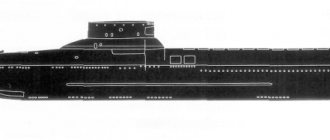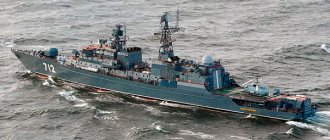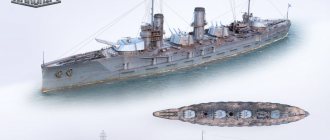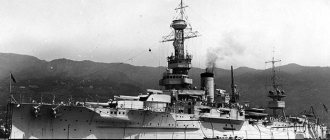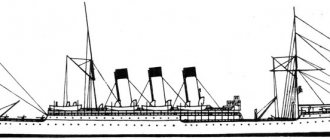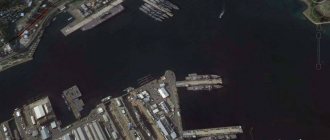Large landing ships of Project 775
Back in the days of the Soviet Union, landing ships of Project 775 were created, designed for amphibious landings with the support of various types of armored vehicles, including tanks, on the unequipped enemy coast. They also serve to transport troops and cargo by sea. The ships of this project are not equipped with aircraft, so support for the landed group is limited only to deck artillery fire of several types.
History of Project 775 large landing ships
A series of large landing ships of the Soviet Project 775 were developed to replace the BDK Project 1171 of the USSR Navy, which was based on a civilian cargo ship and did not fully meet the modern requirements of military sailors. It was necessary to create a specialized ship, structurally optimized for large-scale landing operations, with more powerful weapons and greater survivability than the ships of the previous Project 1171. It is interesting that the design task was placed in Poland, the development was entrusted to the famous shipbuilding engineer O. Vysotsky.
The lead ship had the index SDK-47 and left the slipways of the Polish shipyard Stocznia Polnocna (“Northern Shipyard”) in 1974. In total, in 1974-1991. 28 ships of this project were built. One of them was exported to Yemen in 1979 and converted into a bulk carrier.
There are 15 ships in service, including BDK-91 “Olenegorsky Miner” (entered into the fleet in 1976), BDK-182 “Kondopoga” (1976), BDK-55 “Alexander Otrakovsky” (1978). ), BDK-101 "Oslyabya" (1981), BDK-98 "Admiral Nevelskoy" (1982), BDK-43 "Minsk" (1983), BDK-58 "Kaliningrad" (1984) , BDK-45 "George the Victorious" (1985), BDK-56 "Konstantin Olshansky" (1985), BDK-60 "Alexander Shabalin" (1985), BDK-64 "Caesar Kunikov" (1986 .), BDK-46 "Novocherkassk" (1987), BDK-67 "Yamal" (1988), BDK-54 "Azov" (1990), BDK-11 "Peresvet" (1991) , BDK-61 “Korolev” (1991).
Thus, the ships of this project represent the basis of the fleet of ships of their class in the Russian Black Sea, Baltic, North Sea and Pacific fleets. They were supposed to be replaced by the BDK of the new project 778, but it was frozen.
Design A feature of the Project 775 landing ships is the developed deck superstructure, which is rarely found on ships of this type, since the upper deck is usually given over to runways and areas for aviation. At the stern there is a folding side, which, when folded, hermetically closes the hangar with equipment, and when open, turns into a bridge for loading equipment through the stern.
Project 775 ships are small compared to the British landing ship HMS Ocean and especially the American USS Wasp. Russian BDKs take on board a reinforced company of marines or a detachment of 225 paratroopers (for comparison, HMS Ocean is designed to transport 900, USS Wasp - up to 1,900 paratroopers). In addition to soldiers, up to 10 tanks or other military equipment of comparable weight (480 tons) are taken on board the Project 775 BDK. The radio-electronic equipment of the landing ship includes a radar station for detecting air targets of the MP-302 type, the maximum detection range is 100 km.
Design
A special feature of the Project 775 landing ships is the developed deck superstructure, which is rarely found on ships of this type, since the upper deck is usually given over to runways and areas for aviation. At the stern there is a folding side, which, when folded, hermetically closes the hangar with equipment, and when open, turns into a bridge for loading equipment through the stern.
Project 775 ships are small compared to the British landing ship HMS Ocean and especially the American USS Wasp. Russian BDKs take on board a reinforced company of marines or a detachment of 225 paratroopers (for comparison, HMS Ocean is designed to transport 900, USS Wasp - up to 1,900 paratroopers). In addition to soldiers, up to 10 tanks or other military equipment of comparable weight (480 tons) are taken on board the Project 775 BDK.
The radio-electronic equipment of the landing ship includes a radar station for detecting air targets of the MP-302 type, the maximum detection range is 100 km.
Armament of Project 775 large landing ships
As already noted, Project 775 BDKs are not equipped with aircraft, but artillery weapons are quite developed. It includes a multiple launch rocket system of the MS-73 “Groza” type with a maximum firing range of up to 21 km; post-volume fire from it is carried out at intervals of 0.5 s. In addition, on board there is a 76.2-mm AK-176 automatic installation with a rate of fire of up to 130 rounds per minute, an ammunition load of 152 rounds, a maximum firing range of 15,700 m and an altitude reach of 7,000 m. The armament also includes two double-barreled 57- mm automatic gun mounts of the AK-725 type with a rate of fire of 400 rounds per minute each, an ammunition load of 1000 shells per mount and a maximum firing range of 12,500 m. To enhance the effectiveness of air defense on the BDK there are two six-barreled 30-mm automatic rapid-fire mounts AK-630M. They can be used to engage air targets at ranges up to 4000 m and small surface targets at distances up to 5000 m. The rate of fire is 4000-5000 rounds per minute. Ammunition per barrel - 3000 shells. For air defense there are also two Strela-3 MANPADS.
Armament
As already noted, Project 775 BDKs are not equipped with aircraft, but artillery weapons are quite developed. It includes a multiple launch rocket system of the MS-73 “Groza” type with a maximum firing range of up to 21 km; post-volume fire from it is carried out at intervals of 0.5 s. In addition, there is a 76.2 mm AK-176 automatic mount on board with a rate of fire of up to 130 rounds per minute, an ammunition load of 152 rounds, a maximum firing range of 15,700 m and an altitude reach of 7,000 m.
Russian 30-mm six-barrel rapid-fire gun AK-BZOM. Each of the Project 775 landing ships has two such installations.
The armament also includes two double-barreled 57-mm automatic gun mounts of the AK-725 type with a rate of fire of 400 rounds per minute each, an ammunition load of 1,000 rounds per mount and a maximum firing range of 12,500 m. To enhance the effectiveness of air defense on the BDK there are two six-barreled 30-mm automatic rapid-fire installations AK630M. They can be used to engage air targets at ranges of up to 4,000 m and small surface targets at distances of up to 5,000 m. The rate of fire is 4,000–5,000 rounds per minute. Ammunition per barrel - 3000 shells. For air defense there are also two Strela-3 MANPADS.
Usage
The largest modern operation using Project 775 ships was the delivery of peacekeeping units of the Russian army to war-torn Yugoslavia in August 1999 by a fleet of five Russian large landing craft. Then 260 units of various military equipment and 650 paratroopers were transferred to the port of Thessaloniki in Greece.
During the 2008 armed conflict in South Ossetia, a large landing craft of this type, Caesar Kunikov, on August 10 led a flotilla of ships of the Russian fleet that took part in a naval battle with a group of boats of the Georgian Navy.
Project 775 ships are quite actively used as transporters to supply naval units in distant garrisons of the Pacific Fleet (Kamchatka, Sakhalin, Kola Peninsula, Kuril Islands, etc.). With the outbreak of the civil war in Syria in 2013, the Project 775 landing craft of three Russian fleets took part in the delivery of goods in the interests of the population of territories controlled by the Syrian government.
Use of Project 775 large landing ships
The largest modern operation using Project 775 ships was the delivery of peacekeeping units of the Russian army to war-torn Yugoslavia in August 1999 by a fleet of five Russian large landing craft. Then 260 units of various military equipment and 650 paratroopers were transferred to the port of Thessaloniki in Greece. During the 2008 armed conflict in South Ossetia, a large landing craft of this type, Caesar Kunikov, on August 10 led a flotilla of ships of the Russian fleet that took part in a naval battle with a group of boats of the Georgian Navy. Project 775 ships are quite actively used as transporters to supply naval units in distant garrisons of the Pacific Fleet (Kamchatka, Sakhalin, Kola Peninsula, Kuril Islands, etc.). With the outbreak of the civil war in Syria in 2013, the Project 775 landing craft of three Russian fleets took part in the delivery of goods in the interests of the population of territories controlled by the Syrian government.
By the way, engineers design solutions to various problems, for example door closers https://magazun.com/dovodchiki/ , first of all for military needs, and only after that all kinds of devices begin to appear in civilian homes.
Development history
The Navy needed to replace the aging large landing ships of Project 1171, created on the basis of a dry cargo ship. Their successors had to be designed specifically for landing operations, have greater survivability and weapons power. The new ships were supposed to stand in importance between the Project 1174 BDK (Rhinoceros) and medium landing ships. Design of the 775 was carried out in the Polish People's Republic.
Tactical and Technical Characteristics
5.1 Main characteristics
- Displacement: 2900 t (light), 3450 t (normal), 4400 t (full)
- Length: 112.5 m (longest)
- Width: 15 m (largest)
- Draft: 3.7 m (at full displacement)
- Engines: 2 diesel engines, 3 × diesel generators, 16 ZVB 40/48
- Power: 2 × 9600 l. s., 3 × 750 kW
- Propulsion: 2 × stern retractable propellers, 2 × fixed propellers
- Speed: 17.5 knots (full)
- Cruising range: 3500 miles (at 16 knots), 6000 miles (at 12 knots)
- Sailing autonomy: 30 days
- Crew: 87 people (8 officers).
5.2 Armament
- Navigation weapons: "Don" or "Mius" or "Vaigach" or "Nayada" navigation radars
- Radar weapons: RLSO NTs and VTs MR-302 “Rubka” (project 775/II) or
- MR-352 “Positive” (project 775/III), two MR-212/201 radars
- Electronic weapons: MR-103 “Bars” or MR-123/176 “Vympel” fire control system (Project 775/III), PS-73 “Groza” control system, 2 × 82 mm launchers of the PK-16 complex and MP-405 electronic warfare system "Start" (project 775/III)
- Artillery: 2 × AK-725 or 1 × AK-176 (Project 775/III)
- Anti-aircraft artillery: 2 × AK-630M (Project 775/III)
- Missile weapons: 2 × A-215 "Grad-M" (total - 320 NURS), 2 × MANPADS "Strela-3" or "Igla".
5.3 Landing capabilities
Project 775 BDKs are capable of transporting 10 tanks and 225 paratroopers or a reinforced company of marines. The weight of the cargo compartment is up to 480 tons, its dimensions are 95 × 4.5 × 4.5 m. Accommodation for paratroopers is located in 4-berth officer cabins and cockpits.
Composition of the series
The ships of the project were built from 1975 in Kaliningrad. A total of 15 ships were planned for the series, the last of which was never completed. The 14 built ships of the project were for a long time in the USSR Navy, and later in the Russian Navy. Four ships of this series are still serving in the Black Sea and Pacific fleets. One of the ships sank while being towed. Another one was sold to Ukraine, where it was later converted into a bulk carrier.
- BDK-10 – In service "Saratov"
- BDK-6 – Decommissioned 03/19/1992
- BDK-13 – Decommissioned 07/05/1994
- BDK-62 – Decommissioned 12/01/1997
- BDK-66 – Decommissioned 07/05/1994
- BDK-69 – Orsk in service
- BDK-77 – Decommissioned 07/05/1994
- “Donetsk Miner” – Decommissioned 04/10/2002
- BDK-100 – Sank 06/30/1993
- BDK-104 – Since 2004, bulk carrier “Gorlivka”
- "Peter Ilyichev" - Decommissioned 06/30/1993
- “Nikolai Vilkov” - In service
- "Nikolai Filchenkov" - In service
- “Nikolai Golubets” was not completed.
Story
Development history
The first ceremonial raising of the Navy Flag.
In the 1960s, the Soviet fleet already had a fairly modern ship composition, which allowed it to enter the vastness of the World Ocean. Rivalry with the United States led to an alliance with many states, and the tasks of the USSR were to promptly provide military assistance to its allies. This required the creation of special means. A project was needed for new special ships to deliver various cargoes. So, in 1959, a task appeared to develop a large landing ship for the ocean zone. Among the first projects was 1171 “Tapir” with tactical and technical data comparable to those of modern Western landing ships. Almost simultaneously, the Ministry of the Navy ordered a Project 1173 bulk carrier with a bow ramp, which was supposed to serve the same purposes in wartime. The project was complicated by the fact that it was a fundamentally new ship for the Soviet Navy. The proximity of the purpose of both projects made us remember the planned economy. Both projects were combined into one under the general designation Project 1171 “Tapir”. At the same time, it could be used for both military and civilian purposes, but because of this, its characteristics decreased somewhat. This was due to differences in the requirements of civilian customers (high efficiency, use of the entire volume of holds, good cabins for the crew) and military customers (space for weapons, increased unsinkability, high speed, special equipment), which forced a compromise. The designers drew up many design options, taking into account all the wishes as far as possible, but the undoubted priority was still given to the military. The main factor was the replacement of engines, instead of the planned 2500 hp diesel engines. They decided to install engines of twice the power on it. This suited the Navy, since the ship's speed increased to 17 knots, which was almost equal to the initial assignment. However, the Ministry of the Navy decided to abandon the “joint” vessel, because its operation with such powerful mechanisms became unprofitable. As a result, the dual purpose of Project 1171 “Tapir” was manifested only on the outside, in an appearance more typical of a civilian ship. The ship was classified as a "BDK" (Large Landing Ship) and was built exclusively for the Navy.
Service history
Meeting with RCC “Moscow”, Atlantic. 1976
Passage of the Suez Canal from the Mediterranean to the Indian Ocean. To Somalia with cargo..
Originally part of the 39th Marine Division. While performing combat services in the zone of military conflicts in the Middle East, the BDK repeatedly performed tasks of providing international assistance. In particular, "Nikolai Filchenkov" was based in the ports of Angola (March-July 1976, November 1977 - January 1978). He repeatedly served in combat in the Mediterranean and Red Seas, the Atlantic and Indian Oceans. From 1975 to 2004, it was declared excellent at the end of the year eight times. The best ship in the Black Sea Fleet among ships of the 2nd rank in 1996 and 1997. In August 2000, the BDK Nikolai Filchenkov, as part of a detachment of warships of the Black Sea Fleet, carried out the task of transporting weapons and equipment of the contingent of the Group of Russian Forces in the Transcaucasus from the loading point of Gonio (in the Batumi area) to the landing point Utrishenki (in the Novorossiysk area) over four flights. . In 2001, while carrying out the tasks of transporting military equipment and combat training for more than 100 days, he was away from his home base. On March 23, 2005, in agreement with the competent authorities of Ukraine, he crossed its state border and carried out a training landing of an amphibious assault force in the Feodosia region, which served as a reason to accuse the Ministry of Foreign Affairs of Ukraine the Russian side in “gross violation of the provisions of the bilateral agreement on the status and conditions of the presence of the Russian Black Sea Fleet on the territory of Ukraine.” Currently, the large landing ship "Nikolai Filchenkov" is part of the 197th brigade of landing ships of the 30th DiNK and is actively used in exercises and combat training of the fleet.
Service
The BDK of this project has repeatedly participated in various operations, without loss. These include, for example:
- Evacuation of Soviet citizens from the port of Aden during the Aden Civil War in 1986.
- Evacuation from Nokra Island (Eritrea, then Ethiopia) in 1991.
- Functioning as dry cargo ships to support naval units in Sakhalin, Kamchatka and the Kuril Islands.
- Participation in an international campaign to provide assistance to foreign countries in war zones in the Indian Ocean.
- Delivery of goods to the Syrian government from April 2014 to the present (as part of the Syrian Express campaign).
In the spring of 2014, the crew of one of the ships of this project, Konstantin Olshansky, a large landing craft of the Ukrainian Navy, raised the St. Andrew's flag. As of August 2014, this ship is part of the 197th brigade of landing ships of the Russian Black Sea Fleet.
